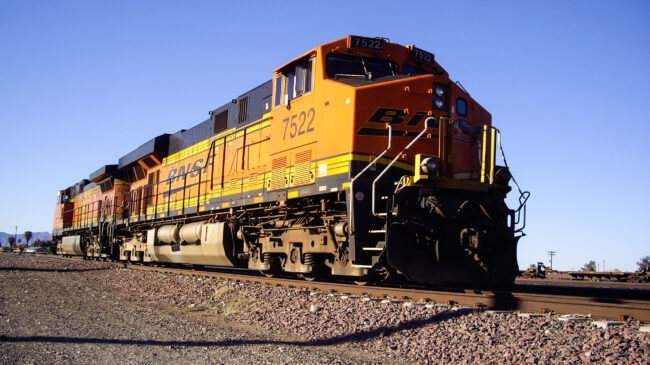A version of these public comments was submitted to the Environmental Protection Agency on April 22, 2024.
On behalf of Reason Foundation, I respectfully submit these comments in response to the Environmental Protection Agency’s (“EPA”) notice of opportunity for public hearing and comment on the California Air Resource Board’s (“CARB”) request for a Clean Air Act Section 209(e) authorization of its In-Use Locomotive Regulation.
By way of background, I am a senior transportation policy analyst at Reason Foundation and focus on matters related to transportation technology. I have testified before Congress on the interactions between freight rail technology and public policy.
Reason Foundation is a national 501(c)(3) public policy research and education organization with expertise across a range of policy areas, including transportation. It is headquartered in Los Angeles, California.
This comment letter develops the following points:
- CARB’s rule mandates unproven technology;
- CARB’s rule would impose large costs;
- CARB’s rule would reduce freight rail’s ability to compete with trucks; and
- A modal shift from rail to truck would increase transportation sector emissions.
- CARB’s Rule Mandates Unproven Technology
Under CARB’s In-Use Locomotive Regulation, freight railroads operating in California would be required by 2030 to adopt zero-emission locomotives for switching and industrial use and by 2035 for line-haul use (pages 5–6). The problem is no zero-emission freight locomotives have been shown to be commercially viable.
Currently, Progress Rail’s EMD SD40JR Joule battery-electric locomotive designed for switching and industrial use is undergoing a year-long test on the Pacific Harbor Line at the Ports of Los Angeles and Long Beach, with similar testing underway in Brazil. For line-haul operations, Wabtec’s FLXdrive battery-electric locomotive is scheduled to begin testing sometime in 2025 in Western Australia.
Whether these novel zero-emission locomotive technologies will prove to be sufficiently reliable and cost-effective to support future commercial operations is unknown. What is known is these technologies are not nearly mature enough to assume they will be commercially viable in time to meet CARB’s aggressive regulatory timeline. This has understandably led engineering expert Bill Schweber to ask about CARB’s In-Use Locomotive Regulation, “Is there a way to achieve it at an acceptable cost, disruption and time frame? And the ultimate question: Is the [zero-emission] gain here worth the many pain points?”
- CARB’s Rule Would Impose Large Costs
In addition to the large costs associated with CARB’s mandate of unproven technology, the In-Use Locomotive Regulation would require early retirement of existing locomotives that do not meet Tier 4 standards (page 5). CARB also requires locomotive operators in California to establish and pay into a Spending Account, a restricted trust from which funds can only be expended for regulatory compliance purposes (pages 4–5).
CARB estimates the In-Use Locomotive Regulation will impose compliance costs of $13.8 billion through 2050 (page 33), with annual costs exceeding $1 billion for several years. The rule does include a Hardship Extension that could delay compliance by up to three years for eligible small railroads, but CARB has accepted that smaller railroads reliant on older locomotives may be bankrupted by its rule and thereby cause communities to lose access to rail service (page 200).
- CARB’s Rule Would Reduce Freight Rail’s Ability to Compete with Trucks
In its Final Statement of Reasons, CARB claims it “did not find empirical research that focused on the impact of regulatory costs on freight diversion or mode shifts from rail to trucks” (page 192). This mirrors an earlier claim contained in CARB’s Initial Statement of Reasons (page 31). However, CARB had, in fact, commissioned a 2016 study from the Rail Transportation and Engineering Center (RailTEC) at the University of Illinois at Urbana-Champaign, which found that a CARB-style locomotive rule
is likely to result in: increased operating costs, delays and network disruption due to locomotive exchange; decreased locomotive utilization, increased locomotive fleet size and the capital cost of establishing extra regional alternative-technology locomotive maintenance, servicing and fueling facilities. According to the European experience, the net result of these outcomes will likely be a decrease in freight rail market share. (page xii)
According to the latest Journal of Commerce Intermodal Savings Index, U.S. shippers could save 27% on annual intermodal rail contracts compared to truckload contracts in the fourth quarter of 2023. Some share of regulatory compliance costs will undoubtedly be borne by rail customers through higher rates. These added regulatory costs will reduce the price differential between rail and truck freight service and will in turn reduce rail’s competitive advantage, particularly in the markets in which it most aggressively competes with trucks.
- A Modal Shift from Rail to Truck Would Increase Transportation Sector Emissions
According to EPA, when compared to freight rail, trucks produce approximately 10 times as much carbon dioxide (CO2), more than three times as much fine particulate matter (PM2.5), and two-and-a-half times as much nitrogen oxides (NOX) per ton-mile. Table 1 provides a breakdown of pollutant emissions intensity by mode.
Table 1: U.S. Freight Transportation Emissions, Rail vs. Truck
| Freight Mode | CO2 (grams/ton-mile) | NOX (g/ton-mi) | PM2.5 (g/ton-mi) |
| Rail | 20.7 | 0.29 | 0.0082 |
| Truck | 210.0 | 0.74 | 0.0270 |
CARB attempts to dismiss concerns about rail-truck modal shift by arguing that a separate truck emissions rule will significantly reduce the emissions of trucks operating in California, thereby negating the emissions increases associated with freight mode substitution. However, CARB’s methodology is simplistic and does not distinguish between truck-tractor types or how those various types are used in transportation.
Even if CARB’s truck emissions regulations survive their present legal challenges, truck-tractors with sleeper cabs—particularly those of owner-operators registered out of state—will face delayed compliance deadlines. It is these trucks that are expected to disproportionately absorb line-haul rail movements. As the RailTEC study commissioned by CARB warns:
The shift of freight from rail to truck reduces the emissions benefits of the alternative locomotive technologies. Technologies that showed emissions reductions before mode shift may show increases in emissions when the induced truck emissions are included in the calculations. (page 16)
Given that trucks emit far more pollutants than trains to move the same volume of freight, a modal shift from rail to truck would increase the air pollution emissions intensity of the transportation sector. CARB’s In-Use Locomotive Regulation, by reducing rail’s cost advantage to trucks, can thus be expected to increase total emissions—at least until zero-emission locomotives are developed and commercialized for line-haul service. Given that long-haul freight movements occur across state lines, CARB’s rule would also have the expected effect of increasing emissions in neighboring states.
CARB’s In-Use Locomotive Regulation mandates unproven technology and would impose large compliance costs. The resulting negative effect on intermodal freight transportation competition would likely increase nationwide emissions. For these reasons, EPA should deny CARB’s Section 209(e) authorization request.
Public Comments: EPA should deny a Clear Air Act waiver for California’s locomotive emissions regulation

